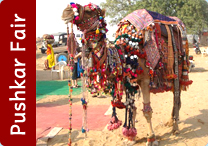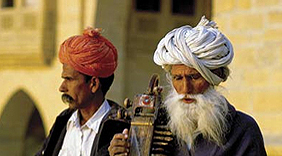
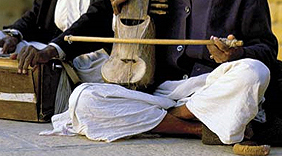

Custom Made Tour
Feel free to let us know if you are looking for customize tour program as all the tour itinerary is sample it can be modify according to your requirements.
Home - Rajasthan Travel Guide - Jaisalmer Tour
Jaisalmer Tour
History of Jaisalmer
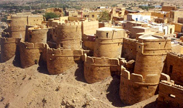
It is one of the most exotic cities of the Orient, standing in the heart of the desert for centuries, weathering with fortitude the vicissitudes of fortune and furious onslaughts of nature. The sudden emergence of the 76-meter high rock in the flat desert country crowned by the most awe-inspiring fort makes a majestic sight.
Today, Jaisalmer is the personification of the old order influence the new. An inherent feel for color and design percolated ever stratum of society, and jewelry, crafts and architecture became objects of delight equally between prince and peasant.
The History of Jaisalmer has a charm of its own. Like all other cities of Rajasthan, Jaisalmer too has its own glorious past to boast about. History of Jaisalmer draws heavily from the history of the Rajputana. The city is said to be founded by one Raja Rawal Jaisal, a Bhatti Rajput ruler, in approximately 1156 A D. Legends go by that he did it on the behest of a local hermit named Eesaal. The raja choose Trikut hill as the new site for his fort. This was because he thought that his previous abode at Luderwa (16 km from present Jaisalmer) was vulnerable towards possible enemy assault.
In medieval times, Jaisalmer continued to be on the focus of the masses because of its location. It falls in the way of one of the two routes, which connected India from Persia, Egypt, Africa and the west. The Bhatti Rajput rulers were still in line. They were the sole guardian of the city and thus mustered enough wealth through taxes levied on the passing caravans, of which there was no scarcity.
 For many years Jaisalmer remained out of bound from the foreign rulers partly because of its location and partly because of its relief. In the mid Thirteenth century, Ala-ud-din Khilji, the Turk-Afghan ruler of Delhi laid the siege over the city. He was apparently upset with the Bhatti Rajput rulers because they stopped and looted one of his caravans containing royal coffer which was on its way to Sind. The siege lasted for around 9 long years and when the fall seemed eminent the Rajput womenfolk of the city committed Jauhar (self Immolation to avoid disgrace).
For many years Jaisalmer remained out of bound from the foreign rulers partly because of its location and partly because of its relief. In the mid Thirteenth century, Ala-ud-din Khilji, the Turk-Afghan ruler of Delhi laid the siege over the city. He was apparently upset with the Bhatti Rajput rulers because they stopped and looted one of his caravans containing royal coffer which was on its way to Sind. The siege lasted for around 9 long years and when the fall seemed eminent the Rajput womenfolk of the city committed Jauhar (self Immolation to avoid disgrace). It is said that Duda, the son of Raja Jaisimha, fought vehemently in the battle but was overpowered after the fierce hand to hand combat. He died fighting. His descendants continued to rule the city. Though they had a cordial relation with the Mughal rulers in Delhi, they fought unsuccessfully with Emperor Humayun. Emperor Shah Jahan gave the right of governance to Sabala Simha, who had the royal patronage and had shown remarkable valor to win the Battle of Peshawar.
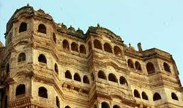
How to Reach Jaisalmer
By Air : Flights are not the best way to reach Jaisalmer. Jodhpur is the nearest airport at a distance of 500 km. Indian Airlines has a twice-weekly service to Jodhpur from Delhi.By Rail : From Jodhpur there is a direct train to Jaisalmer for overnight journey, except on Wednesday. The journey takes approximately ten hours. The Palace on Wheels is the most luxurious way to travel to Jaisalmer, recreating within the coaches the ambience of the legendary palace comforts. Advance reservation required.
By Road : Jaisalmer is 897 kilometers from Delhi; 638 kilometers from Jaipur; 285 kilometers from Jodhpur; 500 kilometers from Ajmer, and 330 kilometers from Bikaner. Most of these places are connected to Jaisalmer by National Highway No 15.
Jaislamer General Information
Area : 5.1sq kmAltitude : 225 meters
 Climate : Mean Max Mean min Summer : 41.6C 25.0C Winter : 23.6C 7.9 C
Climate : Mean Max Mean min Summer : 41.6C 25.0C Winter : 23.6C 7.9 C Rainfall : 15cms
Best Season : October-February
Clothing :
Summer : Light topical
Winter : Heavy woolen
Language : English, Hindi, and Rajasthani.
PLACES OF INTEREST ARE:
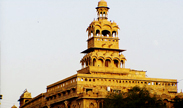
Tazia Tower: The delicate pagoda like Tazia Tower rises from Badal Mahal (Cloud Palace). Rising in its five tiered splendour, with each storey graced by a delicately carved balcony, the tower is of historical significance. Muslim craftsmen built it in the shape of a Tazia and gifted to their royal patron. Tazias are ornately decorated bamboo, paper and tinsel replicas of a bier carried in procession during Mohurram.
 Nathmalji ki Haveli: The late 19th century Haveli with intricate architecture a display of sheer craftsmanship. The left and right wings of the mansion were carved by two brothers are not identical but very similar and balanced in design. The interior walls are ornate with splendid miniature paintings.
Nathmalji ki Haveli: The late 19th century Haveli with intricate architecture a display of sheer craftsmanship. The left and right wings of the mansion were carved by two brothers are not identical but very similar and balanced in design. The interior walls are ornate with splendid miniature paintings.Patwon ki Haveli: The most elaborate and magnificent of the Jaisalmer havelis. It has exquisitely carved pillars and extensive corridors and chambers. One of the apartments of this five story high Haveli is painted with beautiful murals.
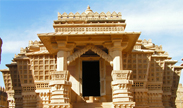
Jain Temple: Being the financers of the Rajputs, the rich and influential Jain community was given full religious liberty; and they built many temples in and around Jaisalmer. The Paraswanath temple is the oldest and the most beautiful of the Jain Temples. The walls of the sanctum are carved with animal and human figures and rising above is a tall Shikhar, which is crowned by an amalak and a waterpot containing a lotus flower.


